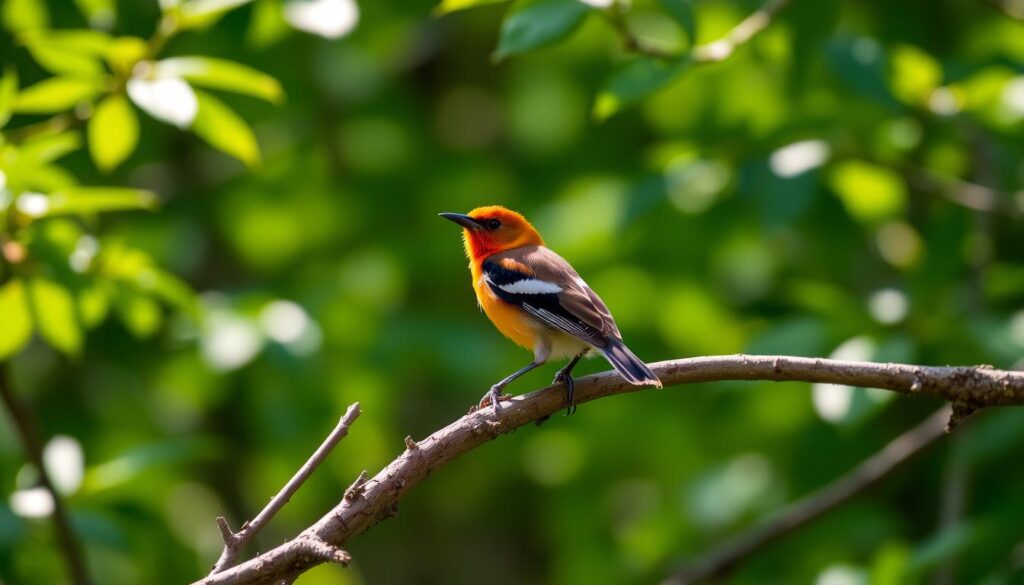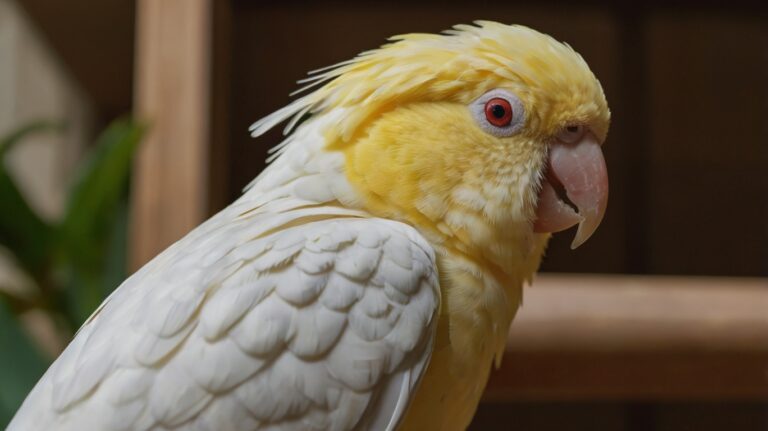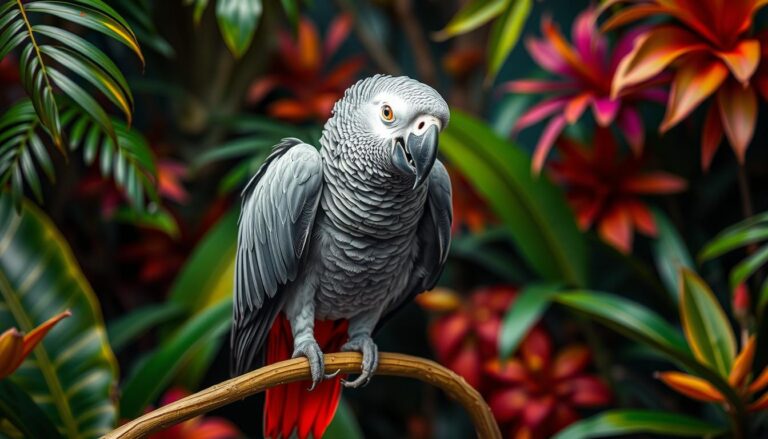American Redstart Bird: Colorful Forest Songbird
As the sun filters through the verdant canopy, a flash of vibrant orange and black catches your eye. It’s the American Redstart, a captivating wood warbler that has enchanted birdwatchers and nature enthusiasts alike. These small, agile songbirds are true marvels of the avian world. They have distinctive plumage, energetic behavior, and an incredible migratory journey.
Let’s dive into the fascinating world of the american redstart bird. It’s a true gem of the eastern North American forests.
| Attribute | Details |
|---|---|
| Official Name | Setophaga ruticilla |
| Common Name | American Redstart |
| Pet Height | 5–6 inches (13–15 cm) |
| Pet Weight | 0.2–0.3 ounces (6–9 g) |
| Lifespan | 5–10 years |
| Smartness Level | Moderate to High |
| Engagement in Play | Active and curious |
| Human-Friendly | Moderate |
| Animal-Friendly | Shy but non-aggressive |
| Favorite Food | Insects, berries, and nectar |
Table of Contents
Distinctive Appearance of the American Redstart
The American Redstart is a bird that catches the eye with its unique look. Males and females have different colors. Males have black bodies, white bellies, and bright orange on their wings, flanks, and tails. This makes the male black and orange bird stand out in the forest.

Females have olive-green upper parts and pale gray and yellow wings, flanks, and tails. Young birds look like females but turn into the iconic black and orange adults in their first year.
Male Plumage: Black with Vibrant Orange Markings
The male american redstart is eye-catching. His black body is a perfect background for his bright orange patches. These colors on his wings, flanks, and tail make him a joy to watch.
Female Plumage: Muted Gray and Yellow Tones
The female american redstart is just as beautiful but in a more subtle way. Her olive-green upper parts and pale gray and yellow colors blend well with the forest. This makes her a perfect part of her natural habitat.
Lively Behavior and Acrobatic Foraging
The american redstart, an insect-eating warbler, is known for its lively and acrobatic ways. These colorful birds are always moving, jumping from branch to branch. They search for insects, their favorite food.
Tail-Fanning to Flush Out Insects
One special thing about the american redstart is tail-fanning. They spread and close their tails fast. This startles insects, making it easier for them to catch.
This acrobatic foraging is amazing to watch. The birds move quickly through the leaves, chasing after their insectivorous diet.
Active Fly-Catching and Insectivorous Diet
- American redstarts are also great at catching flies. They catch insects while flying.
- They mostly eat insects like flies, caterpillars, and spiders. But they also eat berries and small fruits. This is especially true during migration and in their winter homes.
The american redstart‘s lively and acrobatic ways show how adaptable and smart they are. This makes them a joy to watch for bird lovers and nature fans.
Preferred Habitat: Deciduous Forests and Woodlands
The american redstart bird loves many wooded places, especially deciduous forests and mixed woodlands. They live in eastern North America, from southern Canada to the southern United States. Here, they have their breeding grounds.
They like areas full of shrubs and understory vegetation. This gives them plenty of places to find food and build nests.
When they migrate, they visit many types of wooded areas. This includes forests, woodlands, and even urban parks and gardens. Their wintering grounds are in southern Florida and the Caribbean, Central America, and northern South America. They live in forested and semi-open habitats during this time.
| Habitat Type | Region | Season |
|---|---|---|
| Deciduous forests | Eastern North America | Breeding grounds |
| Mixed woodlands | Eastern North America | Breeding grounds |
| Forests, woodlands, urban parks | Eastern North America | Migratory stopover sites |
| Forested and semi-open habitats | Southern Florida, Caribbean, Central and South America | Wintering grounds |
american redstart bird: A Migratory Marvel
The American Redstart is a stunning Neotropical migrant. It’s known for its bright colors and amazing journey across the Americas. As spring comes, these songbirds leave their winter homes in Central and South America. They head to the forests of eastern North America to breed.
Breeding Grounds Across Eastern North America
The American Redstart breeds from southern Canada to the southern United States. They arrive in their nesting spots in mid to late May. In the breeding season, they live in deciduous and mixed forests. There, they help control harmful insects by eating them.
Wintering Habitats in Central and South America
After raising their young, American Redstarts migrate back to Central America, the Caribbean, and northern South America. In the non-breeding season, they live in various forests and semi-open areas. This includes the tropical woodlands of Mexico and the Amazon rainforests.
The American Redstart’s journey is incredible. It migrates over thousands of miles from breeding to wintering areas. This shows their resilience and adaptability.

| Metric | American Redstart | Baltimore Oriole |
|---|---|---|
| Length | 5.25 inches | 8.75 inches |
| Wingspan | 7.75 inches | 12 inches |
| Weight | 0.29 ounces | 1.49 ounces |
The American Redstart is a mid-size bird with striking looks and active foraging. The larger Baltimore Oriole has similar orange hues but is bigger and has a different pattern.
Fascinating Facts About the American Redstart
The American Redstart is a bright bird of the forest. It gets its name from looking like the European Redstart, but they’re not related. This bird has a special way of migrating called “leapfrogging.”
First birds to arrive at a stopover site keep moving. Later birds fill in the spots left behind. Male American Redstarts also have a unique behavior. They can defend two or more territories, each with a female.
This strategy helps them breed more. The maximum lifespan of an American Redstart was recorded at 10 years and 11 months. This shows how long these birds can live and how well they adapt.
These birds are a wonder to researchers and birdwatchers. They show amazing behaviors and adapt to challenges. Their unique ways of living remind us of the wonders of birds and why we should protect them.
Ecological Significance and Conservation
The American redstart is more than a colorful songbird. It’s crucial to the ecosystems it lives in. As an insect eater, it keeps insect numbers in check, including mosquitoes and caterpillars that harm trees. It also spreads seeds, helping plants grow and keeping ecosystems diverse.
These birds are special to birdwatchers and nature lovers. Their bright colors and fun actions make them a joy to watch. This shows why we must protect them and their homes.
Climate change and lost habitats threaten these birds. They arrive in North America sooner each year. Sadly, the American redstart’s survival rate has dropped by over 6%.
We can help these birds by supporting their habitats. We can also reduce light pollution that messes with their migration. Protecting these birds and their homes is key to keeping our world beautiful.

“The migration of birds helps control insect populations and aids in flower pollination while providing nutrients for plants to grow.”
Identification Tips for Birdwatchers
For avid birdwatchers, the american redstart is a true delight to spot in the field. Its distinctive plumage recognition and lively behavioral cues make it easy to identify. This colorful songbird is a joy for both beginner and experienced birders.
Recognizing the Distinctive Plumage and Behavior
The male american redstart is especially striking. It has a jet-black body and vibrant orange patches. These patches flash as the bird darts through the deciduous forests and woodlands it calls home.
Females and juveniles have more muted gray and yellow tones. But their tail-fanning behavior is just as eye-catching as the males’.
Listening for the High-Pitched Song
The american redstart can also be identified by its distinctive high-pitched song. This song often ends in a sharp “shew” sound. Birdwatchers who learn this variable, musical call can spot the american redstart before they see it.
Whether you’re an experienced birder or just starting out, the american redstart is a delightful species. Its striking appearance and lively behavior captivate birdwatchers of all skill levels.
Nesting Habits and Reproduction
The American Redstart is a bright forest songbird with interesting nesting habits. These birds are mostly monogamous. They start their courtship and pair-formation about a week after the females arrive in mid to late May.
The female picks the nest site, often in dense vegetation or against a tree trunk. She builds a cup-shaped nest with grass, feathers, roots, and animal hair. She lays 2 to 5 white or cream-colored eggs, incubating them for 10 to 13 days.
After about 9 days, the young American redstart fledglings leave the nest. They stay with their parents for a while. The breeding season is crucial for these birds to raise their young and ensure the species’ survival.
| Metric | Statistic |
|---|---|
| Mean density of American Redstart pairs per 40 hectares during breeding season in the southeastern U.S. | 2.7-87 pairs per 40 hectares |
| Average density of American Redstarts in northern New Hampshire | 40 pairs per square kilometer in subalpine habitats, 9 pairs per square kilometer in virgin spruce groves |
| Reported range of male territories on 10-hectare sites at the Hubbard Brook Experimental Forest in New Hampshire | 2.5-6.75 territories |
| Territorial densities of American Redstarts in Maryland | 71 males per square kilometer |
| Winter densities of American Redstarts in Jamaica | 10-51 per 10 hectares |
| Mean density of wintering American Redstart pairs per 40 hectares | 2.5 pairs per 40 hectares |
The American Redstart’s nesting and breeding habits are key to its life cycle. Understanding these behaviors helps in conserving and managing this fascinating bird.
Conclusion
The American Redstart is a bird that captures the heart of many. It’s not just a bird; it’s a key player in its ecosystem. Its bright colors and lively actions make it a favorite among birdwatchers and nature lovers.
Learning about the American Redstart’s size, colors, and habits helps us see its importance. It shows us why we need to protect this bird and its home. By doing so, we help keep the balance of nature.
As you learn more about the American Redstart, you can help save it. You can join birdwatching groups or help with science projects. By protecting its home, you ensure this bird will continue to thrive for years to come.







